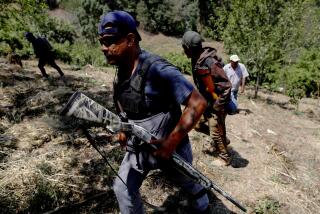U.S. gun laws blamed for worsening Latin American violence
- Share via
Lax U.S. gun regulations are enabling the international trafficking of high-powered weapons and fueling the spread of gun violence in Latin America and the Caribbean, the Council on Foreign Relations argues in a report urging President Obama to take action on initiatives that have foundered in Congress.
More than 70% of the 99,000 weapons recovered by Mexican law enforcement since 2007 were traced to U.S. manufacturers and importers, the council report said, citing data from the eTrace program of the Bureau of Alcohol, Tobacco, Firearms and Explosives. The figure for guns of U.S. origin recovered in the Caribbean is over 90%, the study noted.
“The flow of high-powered weaponry from the United States to Latin America and the Caribbean exacerbates soaring rates of gun-related violence in the region and undermines U.S. influence in the Western Hemisphere,” states the council’s policy memo, written by Latin America studies director Julia Sweig.
The ATF statistics, as well as those of the United Nations Office on Drugs and Crime, suggest the escalating flow of assault weapons from the United States is connected with a 30% higher rate of per capita gun-related homicides in Latin America than the global average. In Mexico, the U.N. homicide report for 2011 charts a more than tripling of firearms slayings in less than a decade.
Mexico’s consul general for Los Angeles, Carlos M. Sada, contends that the share of U.S. weapons recovered in his country from scenes of gun violence are even higher than the eTrace statistics have measured. He puts the guns of U.S. origin at more than 80% and says the issue is one of deep concern for his country as it battles to contain raging violence among the drug cartels.
“Out of the 60,000, or 70,000 or 80,000 people killed in Mexico, how many were killed by weapons smuggled from the United States?” Sada asked rhetorically. “This is an issue that is there and we haven’t been able to stop it.”
In an interview with The Times, Sada noted that it has been months since Obama nominated an ATF director but that his Senate confirmation was still pending early Wednesday, “which gives an idea of how much importance the issue gets in the U.S. Congress.”
Obama nominated B. Todd Jones, a U.S. attorney for Minnesota and acting ATF director since 2011, to head the bureau shortly after the December massacre of schoolchildren in Newtown, Conn. Jones has the support of gun-control advocates, which deterred conservative lawmakers from backing his confirmation. In an unexpected move later Wednesday, the Senate confirmed Jones’ appointment.
Sweig, in her report for the Council on Foreign Relations, suggested that Obama, in the absence of congressional action, take executive and diplomatic steps to reduce trafficking of firearms throughout the Americas.
The recommended measures include expanding nationwide a federal rule in place since 2011 in California, Texas, Arizona, and New Mexico that requires gun dealers to report sales of more than two semiautomatic rifles to the same person within a five-day period.
The report also proposed closer coordination on anti-trafficking efforts with Brazil, the hemisphere’s other firearms industry leader, and to eliminate weapons and ammunition from an export control initiative that would make it easier for U.S. manufacturers to ship weapons abroad.
Sweig said in an interview that she hoped the recommendations would encourage Obama and Vice President Joe Biden to support gun control initiatives at the state level in hope of building momentum toward more effective national restraints.
“This is a long-term strategy,” she said of the goal of reducing the sources of high-powered weapons available to traffickers supplying Latin American criminal operations.
ALSO:Egypt instructs security forces to disperse Morsi supporters
Blog comments lead to terror probe against Chinese rock singer
Al Qaeda leader vows to free Muslims from U.S. prisons, Guantanamo
Twitter: @cjwilliamslat
More to Read
Sign up for Essential California
The most important California stories and recommendations in your inbox every morning.
You may occasionally receive promotional content from the Los Angeles Times.











